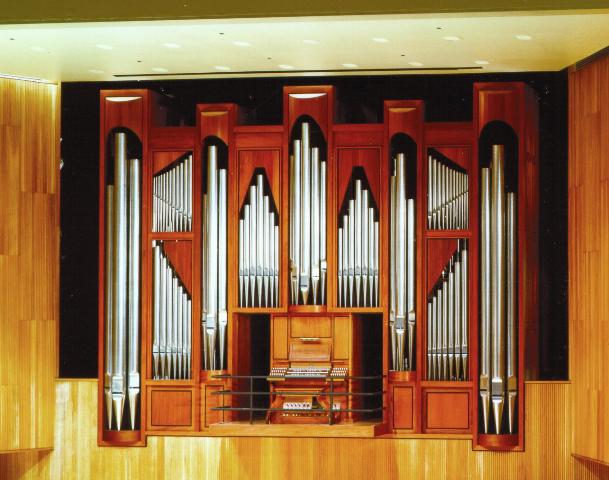|

The Slee Hall Organ State University of New York at Buffalo C.B. Fisk, Op. 95, 1989–90
The Slee Hall organ is a landmark in American organ building, and during its first year or two it attracted visitors from all over the world. It was the crucible out of which emerged a series of major public and university concert hall organs by the Fisk company in Dallas, Seattle, Yokohama, and elsewhere, and its influence has extended to the work of other builders. The design was begun by Charles Fisk in 1978 and was carried through many changes and enlargements by him and, after his death, by his staff, in constant consultation with David Fuller, who saw the instrument through a quarter-century of planning. The conception is deliberately eclectic, but with a strong leaning toward the late 19th-century style of Aristide Cavaillé-Coll, whose instruments were studied by members of the Fisk staff shortly before this organ was built.
The most important determining feature of the instrument, the one that more than any other distinguishes it from previous American practice, is the rising dynamic curve of the manual foundations and reeds, which favors the upper register of the instrument over the lower. This has two musical effects: the melody always sings out over the rest of the texture, and rising and falling phrases are dynamically shaped by the pipes themselves, without the need of artificial means of shading. The large mixture on the Great may be played as a “progressive” mixture, adding ranks as it ascends, to accentuate this rising curve that brings to life the kind of music recorded here. But as a teaching organ the instrument must also be adaptable to earlier music, especially Bach, and by manipulating a pedal the organist may convert this same register to a classical breaking mixture that, combined with the principals based on 17th-century German models (the registers marked “C-C” in the stoplist being omitted), produces a fine Baroque plenum.
The temperament is slightly unequal, favoring F major. A number of the French stops appear here for the first time on a Fisk organ, and the full-length 32' Posaune and immense Bombarde confer an unprecedented grandeur on the Pedal. The most revolutionary innovation, however, is mechanical: the Servo-Pneumatic Lever, developed by Stephen Kowalyshyn and other members of the Fisk staff. Its purpose is to lighten the touch of the Great manual when the other manuals are coupled to it, without compromising the advantages of direct mechanical action. Unlike the Barker machine (an English invention whose first use was by Cavaillé-Coll in 1841), which opens the pallet abruptly at a certain point in the key-fall, this new device causes the pallet to follow the motion of the finger on the key—fast or slow, up or down—but without effort, no matter how many stops or couplers are drawn. The result is greater speed, quieter operation, and total control of the pallet, though without the “feel” of direct action. It was reinvented without knowledge of a similar device: the “floating lever,” invented by Vincent Willis in England more than 100 years ago and used in a few organs before being abandoned in favor of tubular-pneumatic action. Mr. Kowalyshyn’s inspiration came from an experimental swell mechanism of Ernest M. Skinner. The acoustics of Slee Hall, with 700 seats and a reverberation time between two and three seconds, are warm and flattering to the organ; for this, credit belongs to the consultants Klepper, Marshall, and King.
Great, manual I
Prestant 16'
Prestant 8'
Spillpfeife 8'
Violoncelle 8'
Flûte harmonique 8'
Octave 4'
Waldflöte 4'
Twelfth 2 2/3'
Fifteenth 2'
Seventeenth 1 3/5'
Progressive Mixture
Full Mixture IV-VII
German Trumpet 8'
Trompette 8'
Clairon 4'
|
Positive, manual II
Bourdon 16'
Principal 8'
Gedackt 8'
Octave 4'
Baarpijp 4'
Nazard 2 2/3'
Doublet 2'
Quarte de Nazard 2'
Tierce 1 3/5'
Sharp VI-VIII
Cromorne 8'
|
|
Swell, manual III (enclosed)
Flûte traversière 8'
Viole de gambe 8'
Voix cèleste 8'
Flûte octaviante 4'
Octavin 2'
Cornet V (c1)
Basson 16'
Trompette 8'
Hautbois 8'
Voix humaine 8
|
Pedal
Bourdon 32'
Prestant 16' (Great)
Bourdon 16' (32')
Octave 8'
Bourdon 8' (32')
Octave 4'
Mixture IV
Contra Posaune 32'
Bombarde 16'
Posaune 16' (32')
Trompette
|
|
Couplers
Positive to Great
Swell to Great
Swell to Positive
Great to Pedal
Positive to Pedal
Swell to Pedal
Swell Super to Pedal
Suboctaves on Great
Octaves graves
manual key compass CC-a3 (58 notes)
pedal compass CC-f1 (30 notes)
|
Features
Tremulant
Stable Wind
Great off
Great to machine
Kowalyshyn Servo-pneumatic Lever
Great Mixture Bass off
Fisk 1 temperament
Mechanical key & stop action, dual electric stop action
multi-level combination action
|
|